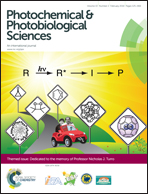Are silicone-supported [C60]-fullerenes an alternative to Ru(ii) polypyridyls for photodynamic solar water disinfection?†
Abstract
Different photosensitizing materials manufactured by immobilizing (0.5–3.0 g m−2) tris(4,7-diphenyl-1,10-phenanthroline)ruthenium(II) (RDP2+), [C60]-fullerene, or 1-(4-methyl)-piperazinylfullerene (MPF) on porous neutral (pSil) or surface-modified anionic (pSil−) poly(dimethylsiloxane) are compared on the grounds of their singlet molecular oxygen (1O2) production and photodynamic solar water disinfection capability. The C60-based sensitizers display a broad weak absorption in the visible and strong absorption in the UV, while absorption of light by RDP2+ supported on pSil is strong in both the UV and blue regions. The 1O2 emission lifetimes (τΔ) determined for RDP2+ and MPF on porous silicone materials under air are similar (40–50 μs) and correspond to the decay of 1O2 generated by sensitizers dissolved in the polymer support. In contrast, τΔ measured for C60 in pSil is similar to that observed for MPF or RDP2+ when immobilized at low loading on pSil, but dramatically increases up to 5 ms if C60 aggregates are formed in the porous material as evidenced by microscopy evaluation. The photosensitizing properties of the dyes, together with their electrical charge and the overall charge of the porous silicone-based materials, lead to highly different sunlight-driven bacteria inactivation efficiencies, as tested with waterborne E. faecalis. RDP/pSil provides efficient disinfection by photosensitization unlike MPF/pSil, which leads to reduced bacteria inactivation rates due to poorer 1O2 production. C60/pSil and MPF/pSil− materials, despite their 1O2 photogeneration, show unsuccessful waterborne bacteria inactivation due to the negative surface charge of fullerene aggregates in contact with water, and to the net negative charge of the pSil−, respectively.
![Graphical abstract: Are silicone-supported [C60]-fullerenes an alternative to Ru(ii) polypyridyls for photodynamic solar water disinfection?](/en/Image/Get?imageInfo.ImageType=GA&imageInfo.ImageIdentifier.ManuscriptID=C3PP50361E&imageInfo.ImageIdentifier.Year=2014)
- This article is part of the themed collection: Dedicated to the memory of Prof. Nicholas J. Turro

 Please wait while we load your content...
Please wait while we load your content...